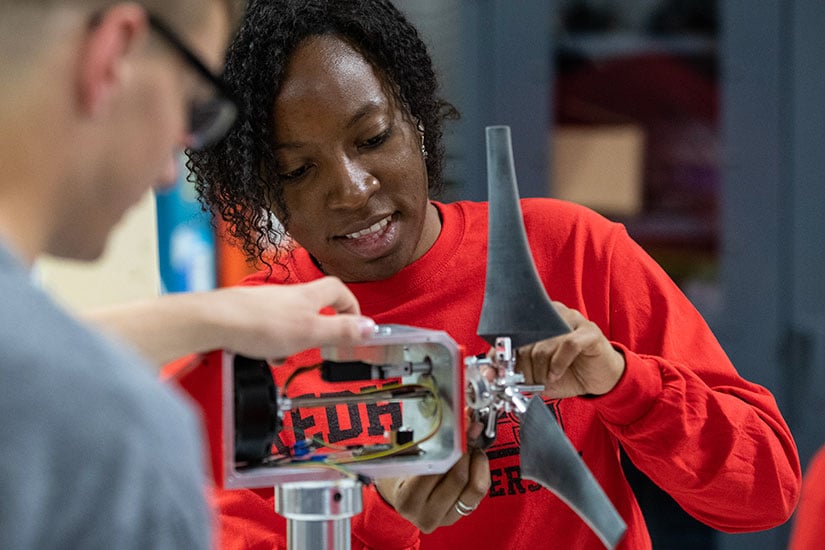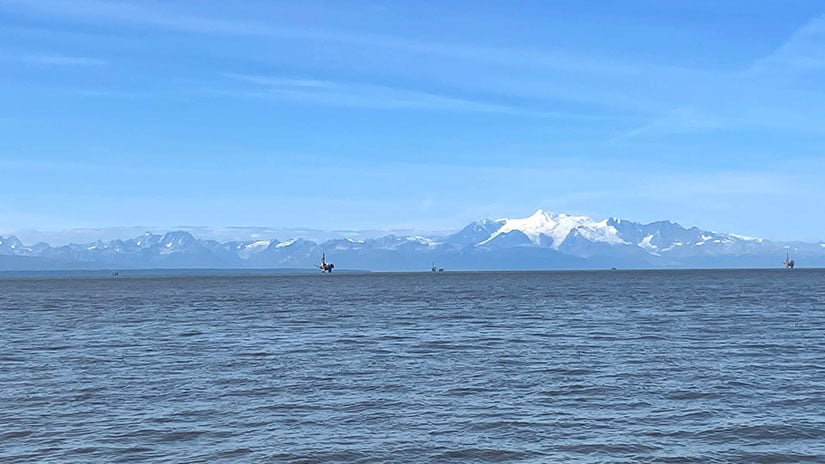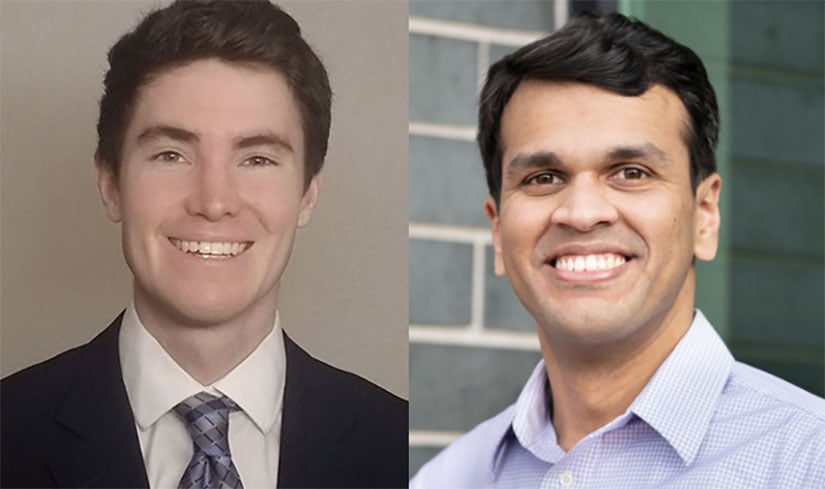The Leading Edge: April 2024 Wind Energy Newsletter
In this issue, NREL shares wind energy workforce news, potential for renewable energy in Alaska, a feature in a revived children’s show, and more.
Upwind: Featured News
NREL Helps Find Opportunity to Increase the U.S. Wind Energy Workforce

A new report authored by National Renewable Energy Laboratory (NREL) researchers estimates that in 2030, the demand for wind energy workers could reach 258,000. However, that number could fall short by 124,000, with the workforce growing to only 134,000 by that time.
The report, funded by U.S. Department of Energy’s (DOE’s) Wind Energy Technologies Office, builds on a 2019 NREL report that identified what researchers called “the wind energy workforce gap.” That gap is caused by the difficulty of employers to find qualified applicants and, concurrently, recent graduates and current workers to find open positions in the wind energy industry.
Designed to better understand current workforce challenges and identify factors that could help narrow the gap, the report investigates what it will take to connect the dots among education, training, entry-level jobs, and long-term careers in the clean energy sector as the United States strives to achieve a 100% net-zero carbon economy by 2050.
Study Reveals Alaska's Vast Offshore Renewable Energy Potential

With support from the Bureau of Ocean Energy Management, NREL researchers assessed the feasibility of ocean-based renewable energy sources for Alaska, focusing on the Outer Continental Shelf. In the study, they estimate Alaskan waters could generate a vast potential of 3,800 gigawatts in wind, wave, and tidal energy, but challenges include logistical issues and the need for clean energy transition strategies for the state’s Railbelt electric grid. The study emphasizes ongoing research and recommends a collaborative, science-based, and inclusive approach to stakeholder engagement to ensure equity and accessibility in supporting Alaska's clean energy transition.
A Favorite 1980’s Children’s Show Takes a New Look at Wind Energy Thanks to an NREL Researcher

When the team behind Fraggle Rock: Back to the Rock—a TV series airing now on Apple+ TV— wanted to focus a seasonal storyline on wind energy, they turned to NREL for expertise. Producers connected with Offshore Wind Energy Group Manager Amy Robertson, who helped the team brainstorm ideas and ensure accuracy in their storyline, in which the character Doc is building model offshore wind turbines and learning about renewable energy. In one scene of the show, a photo of Robertson inside a wind turbine blade is shown on Doc’s office wall of “sheros.” The show’s light, nontechnical approach to offshore wind energy is educational and inspiring for the Fraggles and their young viewers.
Behind the Blades
How Cris Hein Helps Bats and Wind Turbines Share the Sky

Like most everyone, Cris Hein thought all bats were vampire bats. That was 25 years ago, before NREL’s lead environmental scientist began researching the world’s only flying mammal.
Hein always appreciated wildlife. Growing up in the suburbs of Houston, Texas, he liked camping during family vacations and always enjoyed nature shows. But he never dreamed of having a job that focused on wildlife.
While Hein was working on his master’s degree in biology, one of his advisors had an opening to do research on bats. “I jumped at the chance because it seemed really interesting. How many people get to work with bats?” Hein said. “As soon as I started catching, handling, and researching them, I was fascinated by them. And it took off from there.” Read the full interview with Cris Hein.
On the Radar: Project Updates
NREL Researchers to Participate in Summer Program at Stanford University

NREL Researchers Kevin Griffin and Ganesh Vijayakumar will participate in the 2024 Summer Program at the Stanford Center for Turbulence Research with a research project based on their proposal titled, “Hybrid data-informed physics-based model for separation onset over rough surfaces.” The summer program is a biennial event to promote the development and evaluation of new ideas in turbulence research through sustained interaction with researchers at Stanford and visitors from around the world. Funded by the ExaScale Computing Project from DOE Advanced Scientific Computing Research and the Floating Turbine High-Fidelity Modeling project from the Wind Energy Technologies Office, post-doctoral researcher Kevin Griffin has developed a novel approach to accurately predict the onset of stall on flows past aerodynamic objects such as wind turbine blades. NREL researchers will collaborate with international researchers at the 2024 Center for Turbulence Research Summer Program to further study how this work applies to rough surfaces, such as soiled or iced surfaces common on wind turbines, rotorcraft, and aircraft.
Popular Wind Wake Modeling Software Updated
NREL’s FLOw Redirection and Induction in Steady State (FLORIS) development team released FLORIS version 4.0, which includes expanded capabilities that introduce new types of control strategies and make the software more user friendly. FLORIS helps wind energy facilities improve productivity and maximize profits by optimizing wind plant layouts and wind flow control strategies. Updates include features that enhance FLORIS’s functionality and application in real-world plant design and improved software utilization. Check out the full list of changes on GitHub.
Downwind: In Case You Missed It
NREL Study Reveals Causes of Wind Speed Discrepancies

Wind speed bias, or discrepancies between modeled and true wind speed, can affect several activities and industries that rely on accurate wind speed data, such as weather forecasting, aviation, and wind energy production. On behalf of DOE and the Bureau of Ocean Energy Management, NREL researchers collaborated with Pacific Northwest National Laboratory to analyze the causes of high wind speed discrepancies in a 20-year offshore wind resource dataset for California’s Pacific Outer Continental Shelf, publishing their findings in an NREL technical report. That dataset, released in 2020, showed considerable discrepancies between the modeled wind speed and observed wind speed at two different call areas: Humboldt and Morro Bay. Through their analysis, the team found that the choice of atmospheric model setup greatly influenced wind speed accuracy, particularly in stable atmospheric conditions commonly found off the coast of California. These findings highlight the need for additional research to understand discrepancies in widely used wind speed models and their implications for wind energy projects worldwide. Prompted by these findings, NREL published an updated version of the 2020 dataset. This dataset is included in NREL’s 2023 National Offshore Wind data set on OpenEI, which covers all U.S. waters.
Upcoming Events, News Mentions, Recent Publications
Upcoming Events
CLEANPOWER 2024 Conference and Exhibition
May 6–9, 2024, Minneapolis, Minnesota
The American Clean Power Association’s annual conference will feature panels, presentations, workshops, and poster sessions on the renewable energy industry, including land-based, offshore, and distributed wind energy; solar power; energy storage; and transmission.
2024 Collegiate Wind Competition
May 6–9, 2024, Minneapolis, Minnesota
Meet the future clean energy workforce at the Collegiate Wind Competition final event, held May 6–9, 2024, at the American Clean Power Association’s CLEANPOWER Conference and Exhibition in Minneapolis, Minnesota. Engage with aspiring clean energy professionals and learn how to participate in upcoming competition cycles (DOE applications for the 2025 Collegiate Wind Competition are available now). Open to seasoned industry professionals or budding enthusiasts, the College Wind Competition provides the opportunity to network and collaborate with the brightest minds in clean energy. Join us in shaping the future of sustainable energy.
Pacific Offshore Wind Summit 2024
May 13–15, 2024, Sacramento, California
The fourth annual Pacific Offshore Wind Summit will focus on advancing the next critical steps to bring California offshore wind online. The event brings together state and federal officials, industry leaders, and other stakeholders to discuss progress and issues relating to siting, permitting, procurement, transmission, and environmental challenges facing the offshore wind industry in California.
2024 Floating Offshore Wind Shot Summit
May 16, 2024, Sacramento, California
DOE and the U.S. Departments of the Interior, Commerce, and Transportation are hosting the second Floating Offshore Wind Shot Summit. The event will highlight the accomplishments to date, include discussion of near-term priorities for future work, and explore issues central to advancing this emerging and critical technology.
Torque 2024
May 29–31, 2024, Florence, Italy
Join NREL researchers in Florence, Italy for TORQUE 2024, an official event by the European Academy of Wind Energy. Experts from academia and industry will discuss the latest research and developments in applied wind energy research.
Winding Down: End of Service and Recycling for Wind Energy
May 30, 2024, Virtual
In this webinar hosted by DOE's WINDExchange initiative at 1 p.m. ET on May 30, 2024, experts from NREL will introduce attendees to key concepts in DOE's end-of-service processes for wind energy technologies and infrastructure, including decommissioning, repowering, and recycling. As wind energy projects across the United States become older, decisions about end-of-service options and component processing are of growing importance to project owners and operators, state and local decision makers, and neighboring communities. There is also concern about the blade waste that must be processed, with several recycling solutions being developed to meet this need.
News Mentions
Alaska's Wind, Wave, and Tidal Resources Could Help State Meet Future Energy Needs, CleanTechnica, April 21, 2024
Insight Into Unique Project for Floating Offshore Wind Farm, Energy Digital, April 21, 2024
U.S. DOE Report Highlights Ways to Address Significant Wind Energy Workforce Gap, CleanTechnica, April 16, 2024
University of Colorado Boulder Team Reaches Finals in National Collegiate Wind Competition, University of Colorado Boulder, April 16, 2024
DOE Report Analyzes Offshore Wind Energy Transmission on East Coast, Daily Energy Insider, March 25, 2024
DOE Charts Path for Offshore Grid Network, E&E News, March 22, 2024
Recent Publications
Analysis
A 2023 Perspective: What is the Value of Hybridization?, NREL Technical Report (2024)
Definition of the International Energy Agency Wind 22-Megawatt Offshore Reference Wind Turbine, DTU Orbit (2024)
Materials
Structural Characterization of Deployed Thermoplastic and Thermoset Composite Tidal Turbine Blades, NREL Technical Report (2024)
Modeling
Offshore Low-Level Jet Observations and Model Representation Using Lidar Buoy Data Off the California Coast, Wind Energy Science (2024)
Open-Loop Control Codesign of Semisubmersible Floating Offshore Wind Turbines Using Linear Parameter-Varying Models, Journal of Mechanical Design (2023)
Measuring the Effects of Wake Steering With Nacelle-Mounted Scanning Lidar, NREL Technical Report (2024)
Operations and Maintenance
Instrumentation for the Investigation of Pitch Bearing Design and Reliability, NREL Technical Report (2024)
Want More?
Subscribe to The Leading Edge newsletter, and explore the latest news and accomplishments in wind energy at NREL.
Share
Last Updated Nov. 12, 2025
